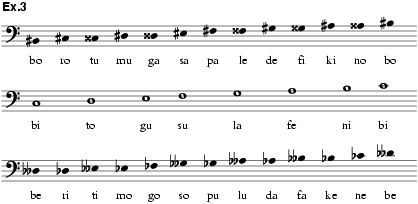
An extremely elaborate solmization system, originally named the ‘Tonwort’ method. It was devised in 1892 by Carl Andreas Eitz (b Wehrstedt, nr Halberstadt, 25 June 1848; d Eisleben, 18 April 1924), a German mathematician and teacher of music at Eisleben. Designed to accommodate the chromatic idiom of the late 19th century, the method provided a separate syllabic note name for each diatonic, chromatic and enharmonic degree of the untempered scale. Using these names, the pupil was taught to identify and sing the notes concerned according to just intonation.
The basis of the system was a series of seven note names: bi, to, gu, su, la, fe and ni, permanently associated with the rising scale of C major. To these syllabic names were added two separate series of related names for the intervening semitones and enharmonic degrees. Diatonic semitones were allotted names which retained the vowel of the parent note (ex.1), while the names of enharmonic notes retained the parent consonant (ex.2). The 31 resultant note names are shown in ex.3.



In a further search for complete purity of intonation Eitz extended this series to embrace the more thorough mathematical division of the octave as previously employed by R.H.M. Bosanquet in his ‘generalized keyboard harmonium’. This instrument, designed to perform in just intonation in all usual keys, was demonstrated by Bosanquet to the Musical Association in London on 1 May 1875. Its tiered keyboard provided four additional keys for each white note and three for each black note, making a total of 53 keys to the octave. Eitz then evolved a complete range of note names, laid out in the form of the Bosanquet keyboard (see illustration). A superlative example of the sacrifice of aesthetic to scientific considerations, so complicated a system could hardly expect to receive general acceptance; though used at an elementary level in Bavarian schools for a time, the Eitz method was formally banned in Prussia between 1914 and 1925.
MGG1 (H. Stephani)
RiemannL12
R.H.M. Bosanquet: ‘Temperament, or the Division of the Octave’, PMA, i (1874–5), 4, 112–58
R.H.M. Bosanquet: An Elementary Treatise on Musical Instruments and Temperament (London, 1876)
C.A. Eitz: Das mathematisch-reine Tonsystem (Leipzig, 1891)
C.A. Eitz: Bausteine zum Schulgesangunterrichte im Sinne der Tonwortmethode (Leipzig, 1911, 2/1928 as Das Tonwort: Bausteine zur musikalischen Volksbildung, ed. F. Bennedik)
C.A. Eitz: Der Gesangunterricht als Grundlage der musikalischen Bildung (Leipzig, 1914)
S. Kleinman: La solmisation mobile de Jean-Jacques Rousseau à John Curwen (Paris, 1974)
BERNARR RAINBOW